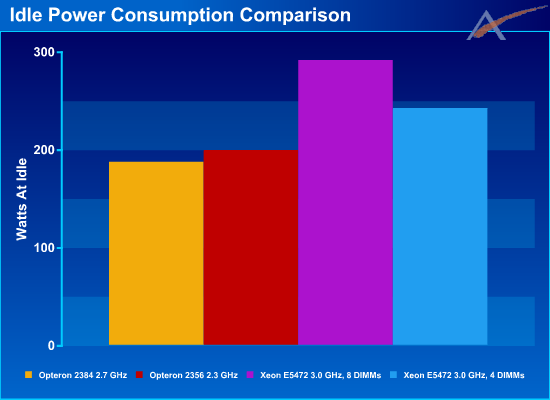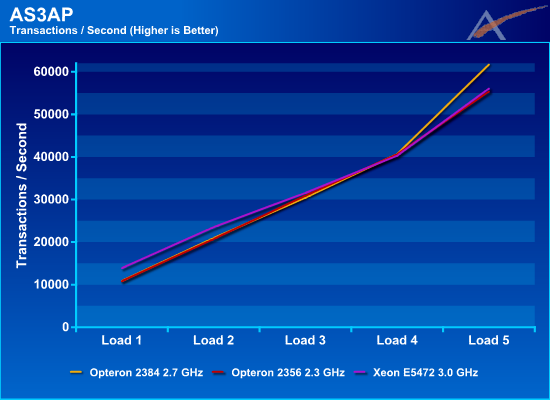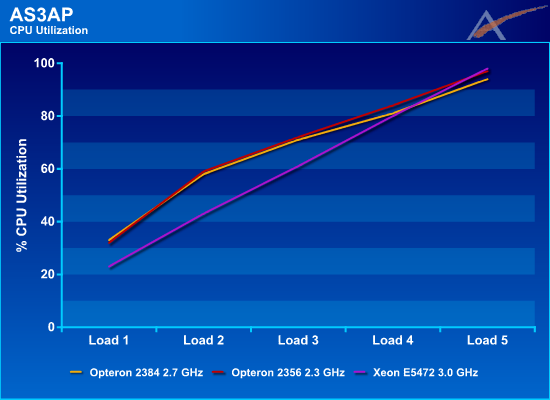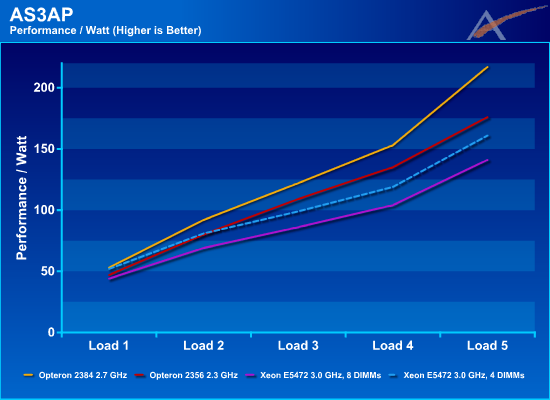AMD Shanghai Launch - Database Testing
by Jason Clark & Ross Whitehead on November 13, 2008 2:00 AM EST- Posted in
- IT Computing
Idle Power and AS3AP Performance

We tested the systems, at idle, with both four DIMM and eight DIMM configurations. The impact was not as significant on the AMD system as it was on the Intel system. The difference in power consumption on the AMD system is only 7W but on the Intel system it was 49W.
Barcelona uses 6% more power at idle than Shanghai. The eight DIMM Intel system uses 56% more power than Shanghai, and the four DIMM Intel system uses 30% more power than Shanghai. A large chunk of this difference on Intel clearly comes from the FB-DIMMs, given the power scaling from four to eight FB-DIMMs, but AMD may still have a slight lead overall even if we discount the memory.

For the first three load points it is close but Intel is able to lead by an average of 15%. Once we hit load point four all systems are almost identical and then with load point five Shanghai is able to lead by as much as 11%. In the first four load points, the performance of Shanghai @ 2.7 GHz vs. Barcelona @ 2.3 GHz is within 2% even though there is a 17% bump in clock. At load point five, Shanghai is able to outpace Barcelona by 11% but still less than the clock bump.

Shanghai and Barcelona exhibit similar CPU usage profiles for the first few load points and then you see that Barcelona @ 2.3 GHz maxes out.

The Opterons are the clear leaders from a power perspective. Shanghai uses approximately 12% less power than Barcelona. Intel uses 27% to 46% more power than Shanghai, depending on the DIMM configuration.

At all load points, Shanghai is the clear winner. For the first four load points Shanghai is again ~12% more efficient than Barcelona, and as much as 28% or 47% more efficient than the Intel systems depending upon the DIMM configuration.
Note: The line for Harpertown four DIMMs is dotted in the above graphs because we did not actually run this configuration but speculate this is the power consumption based on idle power consumption analysis.










30 Comments
View All Comments
piesquared - Wednesday, November 19, 2008 - link
I mean really, how many times AT? You didn't seem to have a problem with i7 results, what's the hold up? Or is this going to be another dfi790, 790fx, 790gx, 780g etc, etc, etc, type of review. You know, the kind where you pay lip service to it, and then go back to cuddling up with Intel.... FraudsLTG - Friday, November 14, 2008 - link
Another power variable I didn't see in the review - The harpertown that matches AMD's price listed is the lower TDP model.The E5450 is 80w TDP
The X5450 is 120w TDP
LTG - Friday, November 14, 2008 - link
Sorry just found it on the benchmark graphs - looks to be the "E" version.LTG - Friday, November 14, 2008 - link
It would be very helpful to know this because almost all new Intel systems support the lower voltage FB-DIMMs.segerstein - Friday, November 14, 2008 - link
Yes, the future will be Muslim. AMD is going to get bought by rich UAEs. The next architecture will be called Istanbul.Why not Byzantium or Constantinople?
Tormeh - Saturday, November 15, 2008 - link
Maybe because Istanbul is an actual place, and not just a historic name?alpha754293 - Thursday, November 13, 2008 - link
You mentioned in this brief review that the FB-DIMMS remove any power efficiency advantage that the Intels othewise might have had.Does the AMD systems also use the FB-DIMMS?
Also, how are you measuring the power consumption because a lot of the charts/graphs look nearly exactly identical, which would seem odd unless it was using the CPU (i.e. all of the application profiles) were EXACTLY identical.
JarredWalton - Thursday, November 13, 2008 - link
AMD does *not* use FB-DIMMs, and very likely never will. The power penalty appears to be something like 7W per FB-DIMM, possibly even a bit more, and the performance advantage... well, it doesn't exist. FB-DIMM was an idea to add more memory on a single channel at the cost of increasing latency. I just don't think it really made enough of a difference to affect the vast majority of server users.Johnniewalker - Thursday, November 13, 2008 - link
Now that would be cool!acejj26 - Thursday, November 13, 2008 - link
Memory frequency is now 800 MHz. Bandwidth is a function of the frequency, but they are not the same.